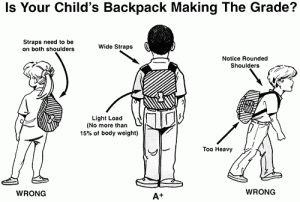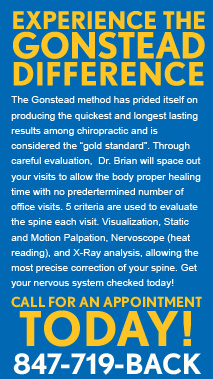Backpacks and Chiropractic
“Children are carrying far too much weight in their backpacks and they are carrying them fashionably but improperly, slung over one shoulder,” Jerome McAndrews, M.D., a chiropractic physician and spokesman for the American Chiropractic Association, said. “The [musculo-skeletal] system has limited rejuvenation possibilities. We’re concerned that the damage that is inflicted now will be showing up 30 years later in even more serious back injuries.”
Backpack loads can be a result of back pain in children, which in part, may be due to changes in lumbar disc height or curvature.


According to the ACA, American Chiropractic Association, students should carry no more than 10% of their body weight in a backpack. Backpacks should have two adjustable and padded shoulder straps, belts around the waist, and fitted padding on the back for support of weight.
How Much is Too Much?
- 50 pounds: 2.5 to 5 pounds
- 80 pounds: 4 to 8 pounds
- 100 pounds: 5 to 10 pounds
- 130 pounds: 6.5 to 13 pounds
- 150 pounds: 7.5 to 15 pounds
What Can You Do?
ACA offers the following tips to help prevent the needless pain that backpack misuse could cause the students in your household.
- Make sure your child’s backpack weighs no more than 5 to 10 percent of his or her body weight. A heavier backpack will cause your child to bend forward in an attempt to support the weight on his or her back, rather than on the shoulders, by the straps.
- The backpack should never hang more than four inches below the waistline. A backpack that hangs too low increases the weight on the shoulders, causing a child to lean forward when walking.
- A backpack with individualized compartments helps in positioning the contents most effectively. Make sure that pointy or bulky objects are packed away from the area that will rest on your child’s back.
- Bigger is not necessarily better. The more room there is in a backpack, the more your child will carry-and the heavier the backpack will be.
- Urge your child to wear both shoulder straps. Lugging the backpack around by one strap can cause the disproportionate shift of weight to one side, leading to neck and muscle spasms, as well as low-back pain.
- Wide, padded straps are very important. Non-padded straps are uncomfortable, and can dig into your child’s shoulders.
- The shoulder straps should be adjustable so the backpack can be fitted to your child’s body. Straps that are too loose can cause the backpack to dangle uncomfortably and cause spinal misalignment and pain.
- If the backpack is still too heavy, talk to your child’s teacher. Ask if your child could leave the heaviest books at school, and bring home only lighter hand-out materials or workbooks.
- Although the use of rollerpacks – or backpacks on wheels – has become popular in recent years, ACA is now recommending that they be used cautiously and on a limited basis by only those students who are not physically able to carry a backpack. Some school districts have begun banning the use of rollerpacks because they clutter hallways, resulting in dangerous trips and falls.

